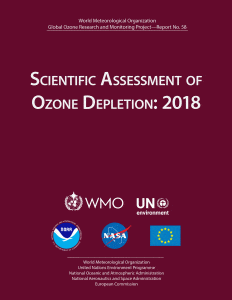The WMO Scientific Assessment of Ozone Depletion provides Parties to the Montreal Protocol with updates on scientific developments relating to ozone depleting substances and the recovery of the stratospheric ozone layer. Together with Andreas Engel and a fantastic team of co-authors, I wrote Chapter 1: Update on Ozone-Depleting Substances (ODSs) and Other Gases of Interest to the Montreal Protocol. Our chapter summarised some really interesting developments that have occurred over the last four years: an increase in global CFC-11 emissions, the identification of new sources of carbon tetrachloride (which helps to reduce the “gap” in our understanding of its global budget), a slow-down in the growth of HCFCs, and many other things. A huge thanks to all the authors whose work we relied on (> 200 papers, mostly from the last four years), and the monitoring networks that make it possible to keep track of changes the concentrations of these important gases.
WMO Scientific Assessment of Ozone Depletion: 2018. Image courtesy: NOAA ESRL.

